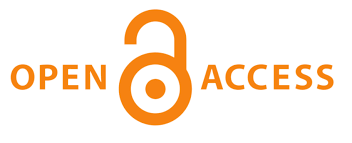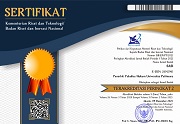Pelaksanaan Sistem Pemerintahan Presidensial Dengan Multi Partai Di Indonesia
 )
)
(1) Fakultas Hukum Universitas Islam Riau, Pekanbaru, Indonesia
 Corresponding Author
Corresponding Author
Abstract
The government system in post-reform Indonesia is a presidential system with many parties. The advantage of this system is that it is more democratic because many parties are considered to accommodate the wishes and interests of people from various backgrounds through political parties, while the weakness is that it is difficult for the ruling party if it is not in the majority. The purpose of this study was to determine the implementation of a presidential system of multi-party governance in post-reform Indonesia. The results of the study are that in a presidential government system with many parties (multi-party system) such as in Indonesia, it will cause problems if no political party wins the election with a majority vote, the President must build a coalition with a number of political parties that have representatives in the House of Representatives (DPR). DPR). Since the holding of the 1999 and 2004 elections, there have been efforts to simplify political parties, by reducing the number of election participants through the electoral threshold and then changing since 2009 to reducing the number of political parties that may sit in parliament by using the minimum threshold requirement (parliamentary threshold). However, this method has not been successful because there are still relatively many political parties sitting in parliament, this is due to the parliamentary threshold that is too small. Ideally, the parliamentary threshold, which was previously 4% in the 2019 election, is raised to 8% in the 2024 election. Thus, a strong, effective and stable presidential government system with only 4 (four) to 6 (six) political parties will be realized.
Keywords
DOI
10.47268/sasi.v27i4.600
Published
2021-12-31
How To Cite
@article{SASI600,
author = {Suparto Suparto},
title = {Pelaksanaan Sistem Pemerintahan Presidensial Dengan Multi Partai Di Indonesia},
journal = {SASI},
volume = {27},
number = {4},
year = {2021},
keywords = {Government System; Multiparty; Parliamentary Threshold},
abstract = {The government system in post-reform Indonesia is a presidential system with many parties. The advantage of this system is that it is more democratic because many parties are considered to accommodate the wishes and interests of people from various backgrounds through political parties, while the weakness is that it is difficult for the ruling party if it is not in the majority. The purpose of this study was to determine the implementation of a presidential system of multi-party governance in post-reform Indonesia. The results of the study are that in a presidential government system with many parties (multi-party system) such as in Indonesia, it will cause problems if no political party wins the election with a majority vote, the President must build a coalition with a number of political parties that have representatives in the House of Representatives (DPR). DPR). Since the holding of the 1999 and 2004 elections, there have been efforts to simplify political parties, by reducing the number of election participants through the electoral threshold and then changing since 2009 to reducing the number of political parties that may sit in parliament by using the minimum threshold requirement (parliamentary threshold). However, this method has not been successful because there are still relatively many political parties sitting in parliament, this is due to the parliamentary threshold that is too small. Ideally, the parliamentary threshold, which was previously 4% in the 2019 election, is raised to 8% in the 2024 election. Thus, a strong, effective and stable presidential government system with only 4 (four) to 6 (six) political parties will be realized.},
issn = {2614-2961}, pages = {516--531} doi = {10.47268/sasi.v27i4.600},
url = {https://fhukum.unpatti.ac.id/jurnal/sasi/article/view/600}
}
Jurnal
[1] Abadi, H. (2011). Perubahan Konstitusi dan Implikasinya Pada Politik Hukum Kepartaian di Indonesia, Mahkamah, 3 (2) : 12-24.
[2] Abadi, H. & M. Sakdan, F. (2013). Mahkamah Konstitusi Dan Pencegahan Perampasan Kekuasaan Oleh Partai Besar, Mahkamah, 5 (1) : 1-8.
[3] Abadi, H. (2014). Presidential Threshold Sebagai Instrumen Proteksi, Mahkamah, 6 (1): 29-36.
[4] Al Arif, M. Y. (2015). Anomali Sistem Pemerintahan Presidensial Pasca Amandemen UUD 1945, Ius Quia Ius Tum, 22 (2) : 238-254, h. 250, DOI : 10.20885/iustum.vol22.iss2.art4.
https://doi.org/10.20885/iustum.vol22.iss2.art4
[5] Arman, Z. (2018). Tinjauan Terhadap Sistem Multi Partai dalam Sistem Pemerintahan Presidensial di Indonesia Pada Era Reformasi, Cahaya Keadilan, 6 (1) : 23-40, h. 35, DOI: https : //doi.org/10.33884/jck.v6i1.875.
https://doi.org/10.33884/jck.v6i1.875
[6] Busroh, F.F. (2017). Reformulasi Penetapan Electoral Threshold Dalam Sistem Kepartaian di Indonesia, Lex Librum, 3 (2) : 513-524, h. 520, DOI : http : //doi.org/10.5281/zenodo.1257770
[7] Chaidir, E. & Suparto, (2017). Implikasi Putusan Mahkamah Konstitusi Tentang Pemilu Serentak Terhadap Pencalonan Presiden dan Wakil Presiden Pada Pemilihan Umum Tahun 2019, UIR Law Review, 1 (1): 1-12, DOI: https://doi.org/10.25299/url.2017.1.01.561.
[8] Efendi, S. (2012). Sistem Pemerintahan Indonesia, Asthabrata, XI (1) : 46-59.
[9] Efriza, (2019). Penguatan Sistem Presidensial Dalam Pemilu Serentak 2019, Jurnal Penelitian Politik, 16 (1) : 1-15.
https://doi.org/10.14203/jpp.v16i1.772
[10] Isra, S. (2013). Hubungan Presiden dan DPR, Konstitusi, 10 (3) : 399-416.
[11] Partono (2008). Sistem Multi Partai Presidensial dan Persoalan Efektifitas Pemerintah, Legislasi Indonesia, 5 (1) : 13-28.
[12] Romli, L. (2011). Reformasi Partai Politik dan Sistem Kepartaian di Indonesia, Politica, 2 (2): 199-220.
[13] Rantau, M.I. (2019). Penguatan Sistem Presidensial di Indonesia
Analisis Terhadap UU No. 7 Tahun 2017 Tentang Pemilihan Umum, Pelita, 19 (2) : 181-193.
https://doi.org/10.33592/pelita.Vol19.Iss2.120
[14] Saraswati, R. (2012). Desain Sistem Pemerintahan Presidensial Yang Efektif, Masalah Masalah Hukum, 41 (1) : 137-143, h. 140, DOI : 10.14710/mmh.41.1.2012.137-143.
[15] Suparto. (2017). Pengujian UU No. 27 Tahun 2009 dan UU No. 17 Tahun 2014 Tentang MPR, DPR, DPD & DPRD (MD3) Sebagai Upaya DPD Untuk Mengembalikan Kewenangan Konstitusionalnya, UIR Law Review, 1 (1) : 13-24, h. 21, DOI : https ://doi.org/10.25299/url.2017.1.01.150.
[16] Suparto (2017). Perbedaan Tafsir Mahkamah Konstitusi Dalam Memutus Perkara Pemilihan Umum Serentak, Yudisial, 10 (1): 1-16, DOI: http://dx.doi.org/10.29123/jy.v10i1.39.
https://doi.org/10.29123/jy.v10i1.39
Buku
[17] Budiardjo, M. (2008). Dasar-Dasar Ilmu Politik Edisi Revisi, Jakarta: Gramedia.
[18] Chaidir, E. & Fahmi, S. (2010). Hukum Perbandingan Konstitusi, Yogyakarta: Total Media.
[19] Haris, S. (2014). Praktik Parlementer Demokrasi Presidensial Indonesia, Yogyakarta: Andi Offset.
[20] Isra, S. (2010). Pergeseran Fungsi Legislasi; Menguatnya Model Legislasi Parlementer dalam Sistem Presidensial Indonesia, Jakarta: Rajawali Pers.
[21] Karsayuda, M. R. (2015). Partai Politik Lokal Untuk Indonesia Kajian Yuridis Ketatanegaraan Pembentukan Partai Politik Lokal di Indonesia Sebagai Negara Kesatuan", Jakarta: Rajawali Pers.
[22] Labolo, M. (2013). Memahami Ilmu Pemerintahan Suatu Kajian, Teori, Konsep dan Pengembangannya, Jakarta: Rajawali Pers.
[23] Marijan, K. (2011). Sistem Politik Indonesia Konsolidasi Demokrasi Pasca Orde-Baru, Jakarta: Kencana.
[24] Sanit, A. (2012). Sistem Politik Indonesia, Jakarta: Rajawali Pers.
[25] Siahaan, P. (2012). Politik Hukum Pembentukan Undang-Undang Pasca Amandemen UUD 1945, Jakarta: Konstitusi Press.
[26] Yudha AR, H. (2010). Presidensialisme Setengah Hati Dari Dilema Ke Kompromi, Jakarta: Gramedia Pustaka Utama.
Cited-By:
1. Multi-party Systems and Parliamentary Thresholds: The Case of Indonesia’s Presidential System with Comparisons to Germany and Taiwan
Karmel Hebron Simatupang
Journal of Political Issues vol: 6 issue: 2 first page: 99 year: 2025
Type: Journal [View Source]
2. The Urgency of Presidential Institution Regulations in Strengthening the Presidential Government System
Widayati Widayati, Mas Nooraini binti Haji Mohiddin, Ratna Herawati, Winanto Winanto
LAW REFORM vol: 19 issue: 2 first page: 199 year: 2023
Type: Journal [View Source]
| Dublin Core | PKP Metadata Items | Metadata for this Document | |
| 1. | Title | Title of document | Pelaksanaan Sistem Pemerintahan Presidensial Dengan Multi Partai Di Indonesia |
| 2. | Creator | Author's name, affiliation, country | Suparto Suparto; Fakultas Hukum Universitas Islam Riau, Pekanbaru; Indonesia |
| 3. | Subject | Discipline(s) | |
| 3. | Subject | Keyword(s) | Government System; Multiparty; Parliamentary Threshold |
| 4. | Description | Abstract | The government system in post-reform Indonesia is a presidential system with many parties. The advantage of this system is that it is more democratic because many parties are considered to accommodate the wishes and interests of people from various backgrounds through political parties, while the weakness is that it is difficult for the ruling party if it is not in the majority. The purpose of this study was to determine the implementation of a presidential system of multi-party governance in post-reform Indonesia. The results of the study are that in a presidential government system with many parties (multi-party system) such as in Indonesia, it will cause problems if no political party wins the election with a majority vote, the President must build a coalition with a number of political parties that have representatives in the House of Representatives (DPR). DPR). Since the holding of the 1999 and 2004 elections, there have been efforts to simplify political parties, by reducing the number of election participants through the electoral threshold and then changing since 2009 to reducing the number of political parties that may sit in parliament by using the minimum threshold requirement (parliamentary threshold). However, this method has not been successful because there are still relatively many political parties sitting in parliament, this is due to the parliamentary threshold that is too small. Ideally, the parliamentary threshold, which was previously 4% in the 2019 election, is raised to 8% in the 2024 election. Thus, a strong, effective and stable presidential government system with only 4 (four) to 6 (six) political parties will be realized. |
| 5. | Publisher | Organizing agency, location | Faculty of Law, Universitas Pattimura |
| 6. | Contributor | Sponsor(s) | |
| 7. | Date | (YYYY-MM-DD) | 2021-12-31 |
| 8. | Type | Status & genre | Peer-reviewed Article |
| 8. | Type | Type | |
| 9. | Format | File format | |
| 10. | Identifier | Uniform Resource Identifier | https://fhukum.unpatti.ac.id/jurnal/sasi/article/view/600 |
| 10. | Identifier | Digital Object Identifier | 10.47268/sasi.v27i4.600 |
| 11. | Source | Title; vol., no. (year) | SASI; Vol 27, No 4 (2021): Volume 27 Nomor 4, Oktober - Desember 2021 |
| 12. | Language | English=en | en |
| 13. | Relation | Supp. Files | |
| 14. | Coverage | Geo-spatial location, chronological period, research sample (gender, age, etc.) | |
| 15. | Rights | Copyright and permissions | Copyright: Authors who publish their manuscripts in this Journal agree to the following conditions: 1. The copyright in each article belongs to the author, as well as the right to patent. 2. Authors can enter into separate, additional contractual arrangements for the non-exclusive distribution of the journal's published version of the work (e.g., post it to an institutional repository or publish it in a book), with an acknowledgment of its initial publication in this journal. 3. Authors are permitted and encouraged to post their work online (e.g., in institutional repositories or on their website) before and during the submission process, as it can lead to productive exchanges, as well as earlier and greater citation of published work. 4. Authors have the right to self-archiving of the article (Author Self-Archiving Policy)
License: The SASI Journal is disseminated based on the Creative Commons Attribution-NonCommercial 4.0 International license terms. This license allows anyone to copy and redistribute this material in any form or format, compose, modify, and make derivatives of this material for any purpose. You cannot use this material for commercial purposes. You must specify an appropriate name, include a link to the license, and certify that any changes have been made. You can do this in a way that is appropriate but does not imply that the licensor supports you or your use.
|
Copyright (c) 2021 Suparto Suparto

This work is licensed under a Creative Commons Attribution-NonCommercial 4.0 International License.
Cited-By:
1. Multi-party Systems and Parliamentary Thresholds: The Case of Indonesia’s Presidential System with Comparisons to Germany and Taiwan
Karmel Hebron Simatupang
Journal of Political Issues vol: 6 issue: 2 first page: 99 year: 2025
Type: Journal [View Source]
2. The Urgency of Presidential Institution Regulations in Strengthening the Presidential Government System
Widayati Widayati, Mas Nooraini binti Haji Mohiddin, Ratna Herawati, Winanto Winanto
LAW REFORM vol: 19 issue: 2 first page: 199 year: 2023
Type: Journal [View Source]

 : 16769 times
: 16769 times Download : 3996 times
Download : 3996 times
















